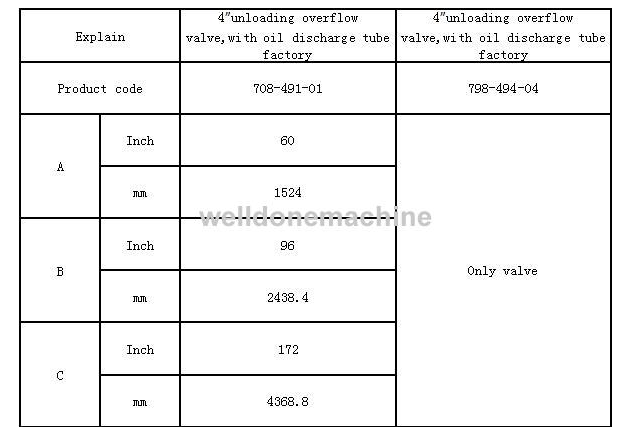WDAOV

The automatic unloading overflow valve you've described is a safety mechanism designed to prevent overfilling of underground storage tanks (USTs) during the oil unloading process. This valve operates independently of the primary throttle valve and is specifically designed to prevent gravity-driven oil transmission from overflowing the tank.
Here's how it works:
Float-Activated System: The valve incorporates two floats, a low float and a high float, that are designed to rise as the oil level in the tank increases. These floats trigger the valve's operation based on the oil level in the tank.
Low Float Activation: When the oil level in the tank reaches approximately 92% of its storage capacity, the low float rises, triggering the main poppet valve of the unloading overflow valve to start working. This reduces the unloading flow to about 10% of the normal oil amount, allowing the tank to fill more slowly and reducing the risk of overflow.
"Line Shock" Prevention: As the main lift valve closes, the sudden drop in flow can cause a "line shock" in the oil discharge pipe. The valve's design helps to minimize this shock, protecting the piping system from damage.
High Float Activation: As the oil level continues to rise and approaches 95% of the tank's capacity, the high float rises, triggering a signal to the unloading valve driver. This signals the driver to stop discharging oil into the tank.
Residual Oil Discharge: After the unloading process is stopped, any residual oil in the unloading oil pipe is disconnected and discharged to prevent it from flowing back into the tank and causing an overflow.
Final Capacity Alert: When the tank reaches 95% capacity, the valve ensures that the unloading process is completely stopped, preventing any further oil from entering the tank and ensuring the safety of the storage system.
The advantages for the automatic unloading overflow valve or a similar valve design are indeed valuable features that contribute to its overall performance and safety. Here's a breakdown of each advantage:
Spring Loaded Two-Stop Damper:
Vertical Floating Body Design:
The vertical floating body design allows the valve to be removed from the tank even when the tank is full. This feature is important for maintenance and repair purposes, as it eliminates the need to empty the tank completely before accessing the valve. It saves time and resources and ensures that the valve can be serviced or replaced as needed without disrupting the tank's operation.
Check Test Port:
The inclusion of a check test port allows for easy testing and verification of the valve's operation without having to fully disassemble the valve or disrupt the flow of oil. This feature simplifies maintenance and ensures that the valve is functioning properly, helping to prevent unexpected failures or overflows.
Pipe Bottom with Screwthread:
The pipe bottom with screwthread facilitates easy installation and removal of the valve from the piping system. This design ensures a secure and leak-proof connection between the valve and the piping, while also making it easier for technicians to access and service the valve as needed. The screwthread also allows for the use of standard pipe fittings and tools, making maintenance and repairs more straightforward.
Overall, these advantages contribute to the reliability, safety, and ease of maintenance of the automatic unloading overflow valve. They ensure that the valve operates smoothly and effectively, helping to prevent overflows and protect the integrity of the underground storage tank system.

Installation
Adding this specific application detail is crucial for ensuring the safe and proper use of the automatic unloading overflow valve. Here's a further explanation of why this valve is designed exclusively for underground storage tanks and the dangers of misusing it:
Designed for Underground Storage Tanks:
The valve's design takes into account the unique conditions and requirements of underground storage tanks. These tanks are typically used to store large quantities of liquids, such as fuel or water, and are buried beneath the ground for safety and space-saving purposes. The valve's features, such as the vertical floating body design and the spring-loaded two-stop damper, are optimized for use in these environments, where access to the valve can be limited and the effects of gravity and pressure can be significant.
Gravity Unloading Only:
The valve is specifically intended for gravity unloading, which means it relies on the natural force of gravity to drain the liquid from the tank. This is a common method of unloading liquids from underground storage tanks, as it requires no additional energy source and can be done safely and efficiently. Attempting to use the valve for pressurized unloading or in any other manner not intended by the manufacturer can compromise its effectiveness and lead to dangerous situations.
Dangers of Misuse:
Using the valve in a ground tank or for any application other than gravity unloading can have severe consequences. Ground tanks are subject to different pressures, temperatures, and other environmental factors than underground tanks, which can affect the valve's performance. Additionally, attempting to use the valve for pressurized unloading can cause it to malfunction or fail, potentially leading to leaks, spills, or even explosions. These hazards not only pose a threat to the environment but also to the safety of personnel working in the area.
Therefore, it is essential to follow the manufacturer's instructions and use the automatic unloading overflow valve only for its intended purpose and in the specified application. This will ensure that the valve operates safely and effectively, protecting the integrity of the underground storage tank system and preventing dangerous situations from occurring.